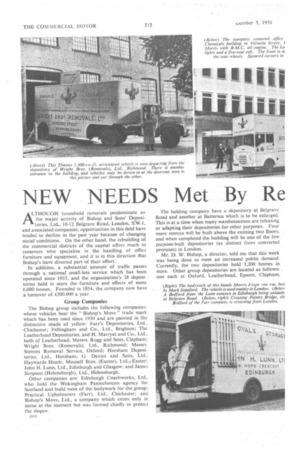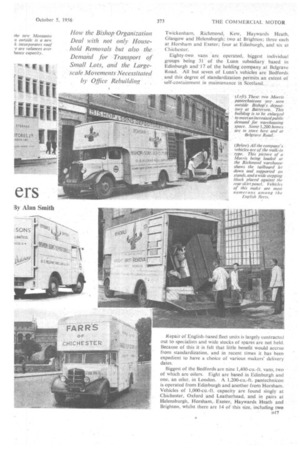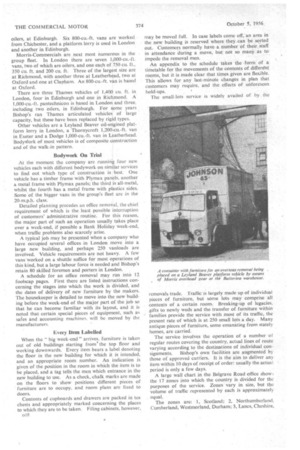NEW NEEDS Met By Re ers
Page 56

Page 57

Page 58

Page 59

If you've noticed an error in this article please click here to report it so we can fix it.
Ely Alan Smith
LTHOUGH household removals predominate as the major activity of Bishop and Sons' Deposi tories, Ltd., 10-12 Be[grave Road, London, S.W.1, and associated companies, opportunities in this field have tended to decline in the past year because of changing social conditions. On the other hand, the rebuilding of the commercial districts of the capital offers much to removers who specialize in the handling of office furniture and equipment, and it is in this direction that Bishop's have diverted part of their effort, In addition, a substantial amount of traffic passes through a national small-lots service which has been operated since 1935, and the organization's 28 depositories hold in store the furniture and effects of some 6,006 homes. Founded in 1854. the company now have a turnover of £500,000 a year.
Group Companies
The Bishop group includes the following companies. whose vehicles bear the "Bishop's Move" trade mark which has been used since 1930 and are painted in the distinctive shade of yellow: Farr's Depositories, Ltd.,
• Chichester; Fellingham and Co., Ltd., Brighton; The Leatherhead Depositories, and H. Marryat and Co., Ltd., both of Leatherhead; Messrs. Rugg and Sons, Clapham; Wright Bros. (Removals), Ltd., Richmond; Messrs, Stevens Removal Service, Oxford; Horsham Depositories, Ltd., Horsham; G. Davies and Sons, Ltd., Haywards Heath; Mousell Bros. (Exeter), Ltd.,. Exeter John 1-f. Lunn, Ltd., Edinburgh and Glasgow; and Jame,, Simpson (Helensburgh), Ltd., Helensburgh.
Other companies are: Edinburgh Coachworks, Ltd., who hold the Wokingham Pantechnicon agency for Scotland and build most of the bodywork for the group: Practical Upholsterers (Farr), Ltd., Chichester; and Bishop's Move, Ltd., a company which exists only in name at the moment but was formed chiefly to protect the slogan.
n16 The holding company have a depository at Belgrave Road and another at Battersea which is to be enlarged. This is at a time when many warehousemen are releasing or adapting their depositories for other purposes. Four more storeys will be built above the existing two floors, and when completed the building will be one of the few purpose-built depositories (as distinct from converted premises) in London.
Mr. D. W. Bishop, a director, told me that this work was being done to meet an increased public demand. Currently, the two depositories hold 1,200 homes in store. Other group depositories are located as follows: . one each at Oxford, Leatherhead, Epsom, Clapham, Twickenham, Richmond, Kew, Haywards Heath. Glasgow and Helensburgh; two at Brighton; three each at Horsham and Exeter; four at Edinburgh, and six at Chichester.
Eighty-two vans arc operated, biggest individual groups being 31 of the Lunn subsidiary based in Edinburgh and 17 of the holding company at Belgrave Road. All but seven of Lunn's vehicles are Bedfords and this degree of standardization permits an extent of self-containment in maintenance in Scotland.
Repair of English-based fleet units is largely contracted out to specialists and wide stocks of spares are not held. Because of this it is felt that little benefit would accrue from standardization, and in recent times it has been expedient to have a choice of various makers' delivery dates.
Biggest of the Bedfords are nine 1,400-cu.-ft. vans, two of which are oilers. Eight are based in Edinburgh and one, an oiler, in London. A 1,200-cu.-ft. pantechnicon is operated from Edinburgh and another from Horsham. Vehicles of 1,000-cu.-ft. capacity are found singly at Chichester, Oxford and Leatherhead, and in pairs at Helensburgh, Horsham,Exeter, Haywards Heath and Brighton, whilst there are 14 of this size. including two oilers, at Edinburgh. Six 800-cu.-ft. vans are worked from Chichester, and a platform lorry is used in London and another in Edinburgh.
Morris-Commercials are next most numerous in the group fleet. In London there are seven 1,000-cu.-ft. vans, two of which are oilers, and one each of 750 cu. ft., 350 Cu. ft. and 200 cu. ft. Three of the largest size are at Richmond, with another three at Leatherhead, two at Oxford and one at Clapham. An 800-cu.-ft. van is based at Oxford.
There are three Thames vehicles of 1,400 cu. ft, in London, four in Edinburgh and one in Richmond. A 1,000-cu.-ft. pantechnicon is based in London and three, including two oilers, in Edinburgh. For some years Bishop's ran Thames articulated vehicles of large capacity, but these have been replaced by rigid types.
Other vehicles are a Leyland Beaver oil-engined platform lorry in London, a Thornycroft 1,200-cu.-ft. van in Exeter and a Dodge 1,000-cu,-ft. van in Leatherhead, Bodywork of most vehicles is of composite construction and of the walk-in pattern.
Bodywork On Trial
At the moment the company are running four new vehicles each with different bodywork on similar services to find out which type of construction is best. One vehicle has a timber frame with Plymax panels, another a metal frame with Plyrnax panels; the third is all-metal, whilst the fourth has a metal frame with plastics sides. Some of the bigger vans in the group's fleet are in the 20-m.p.h. class.
Detailed planning precedes an office removal, the chief requirement of which is the least possible interruption of customers' administrative routine. For this reason, the major part of such an operation usually takes place over a week-end, if possible a Bank Holiday week-end, when traffic problems also scarcely arise.
A typical job may be presented when a company who have occupied several offices in London move into a large new building, and perhaps 250 vanloads are involved. Vehicle requirements are not heavy. A few vans 'worked on a shuttle suffice for most operations of this kind, but a large labour force is needed and Bishop's retain 80 skilled foremen and porters in London.
A schedule for an office removal may run into 12 foolscap pages. First there are listed instructions concerning the stages into which the work is divided, and the dates of delivery of new furniture by the makers. The housekeeper is detailed to move into the new building before the week-end of the major part of 'the job so that he can become familiar with its layout, and it is noted that certain special pieces of equipment, such as safes and accounting machines, will be moved by the manufacturers.
Every Item Labelled
When the "big week-end" arrives, furniture is taken out of old buildings starting from' the top floor and working downwards. Every item bears a label denoting the floor in the new building for which it is intended, and an appropriate room number. An indication is given of the position in the room in which the item is to be placed, and a tag tells the men which entrance in the new building to use. As a check, chalk marks are made on the floors to show positions different pieces of furniture are to occupy, and room plans are fixed to doors.
Contents of cupboards and drawers are packed in tea chests and appropriately marked concerning the places to which they are to be taken. Filing cabinets, however, D 1 g may be moved full. In case labels come off; an area in the new building is reserved where they can be sorted out. Customers normally have a number of their staff in attendance during a move, but not so many as to impede the removal men.
An appendix to the schedule takes the .form of a timetable for.the movements of the contents of different rooms, but it is made clear, that times given are flexible. This allows for any last-minute changes in plan that customers may require, and the effects of unforeseen hold-ups.
The small-lots service is widely availed of by the removals trade. Traffic is largely made up of individual pieces of furniture, but some lots may comprise all contents of a certain room. Breaking-up of legacies. gifts to newly weds and the transfer of furniture within families provide the service with most of its traffic, the present rate of which is at 250 small lots a day. Many antique pieces of furniture, some emanating from stately homes, are carried.
The service involves the operation of a number of regular routes covering the country, actual lines of route varying according to the destinations of individual consignments. Bishop's own facilities are augmented by those of approved carriers. It is the aim to deliver any item within 10 days of receipt of order: usually the actual period is only a few days.
A large wall chart in the Belgrave Road office shows the 17 zones into which the country is divided for the purposes of the service. Zones vary in size, but the volume of traffic represented by each is approximately equal.
The zones are: 1, Scotland; 2, Northumberland, Cumberland, Westmorland, Durham; 3, Lanes, Cheshire, Staffs, Salop; 4, Yorks, Derbys, Notts; 5, Norfolk, Carribs, Suffolk; 6, Herefords, Gloucs, Worcs; 7, Wales; 8, Leics, Lines, Rutland, Northants, Hunts, Warwicks; 9, Oxon, Berks, Bucks; 10, Beds, Herts; 11, London; 12, Surrey; 13, Essex; 14, Kent; 15, Sussex; 16, Hants, Wilts, Dorset; and 17, Somerset, Devon, Cornwall.
At Belgrave Road, a reception area on the ground floor of the premises is set aside for the reception and sorting of small lots and is divided into sections according to the zones mentioned. Variety of 'items is incredible. in a quick look round there I saw, besides the many different pieces of furniture to be expected, a grand piano, a model ship worth £20,000 in a glass case, several butterfly cabinets, and a Lewis gun.
London-Scotland Route
The netWork provides deliveries on the LondonScotland route several times a week, and once a week to elsewhere in the country except Lincolnshire, which is served fortnightly. The service extends to Ireland with two crossings a week. Licence conditions allow new furniture and household apparatus to be delivered, and many manufacturers of domestic appliances, television sets and so on use the service for the distribution of goods to places to which they cannot conveniently send bulk loads. The amount of traffic handled enables the company to charge only slightly more per unit than if the loads represented single consignments.
Chief artery is the London-Scotland route and practically every day Belgrave Road is advised from Edinburgh of southbound vans. In return goes a list of deliveries for the northbound journeys. At least one vehicle is dispatched from either terminal every day, and sometimes there may . be four. If extra vehicles are required, the service can be supplemented by London-based vehicles.
On the chart referred to there are spaces in which notes may be made of the customers' orders, and at a glance the state of traffic availability relative to vehicle capacity may be appraised. A charges reckoner is handy. As nine out of 10 removal orders come by telephone, it is important to be able to tell a customer how soon a job can be done and quote the price quickly. By 9 a.m. each morning, the chart is rearranged, completed orders being deleted and outstanding deliveries aggregated so that the vehicle-operation plan may be examined.
Today most household removals entail the use of only one big van, although occasionally more may be needed. Bishop's usually manage to arrange return loads for their own vehicles.
Many overseas removals are contracted, especially -when large companies dispatch staff to different parts of the world. Documentation for such work is intricate, and there is sometimes difficulty in obtaining shipping space. There exists, however, an international arrangement for the notification of the movements of lift vans.
Bishop's themselves own 100 of these. .
Wheeled Trolley A useful appliance designed by the company is a small rubber-padded trolley mounted on four castor wheels.
A number is in use, chiefly on industrial removals, and the movement of heavy furniture is facilitated.
Vehicle operating costs are separately totalled for each van monthly, and at the end of the year figures are worked out to show a running cost per mile and a standing charge per working day. Depreciation is spread over 10 years. Maintenance carried out in the company's own workshops in England extends to-monthly servicing and, in the case of oilers, the changing of injectors at 10,000 miles. Equipment for the replacement of major components exists at Belgrave Road. Except for vans engaged upon the London-Scotland run and which cover 40,000-50,000 miles a year, vehicles average 20,000 miles a year.
















































































































